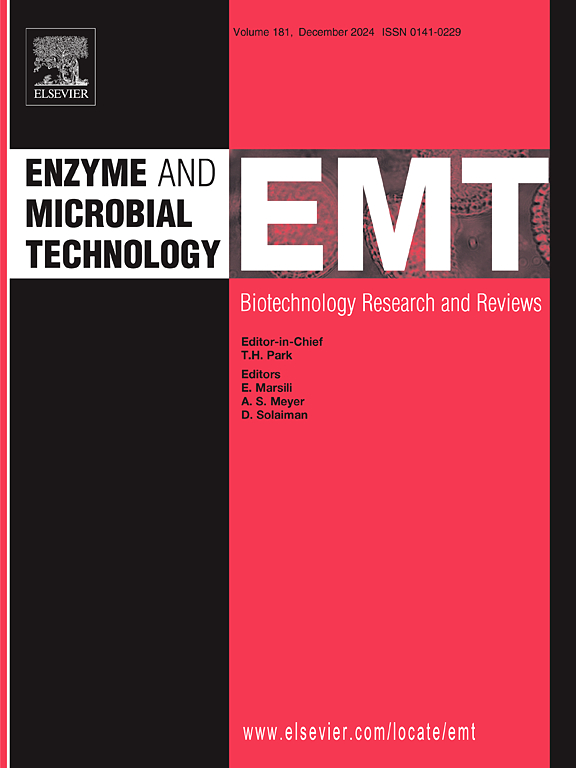Comparison of novel α-glucosidases in glycoside hydrolase family 97 isolated from Bacteroides thetaiotaomicron
IF 3.7
3区 生物学
Q2 BIOTECHNOLOGY & APPLIED MICROBIOLOGY
引用次数: 0
Abstract
In this study, three genes encoding novel Glycoside Hydrolase (GH) 97 enzymes were cloned from Bacteroides thetaiotaomicron and expressed in Escherichia coli. The recombinant enzymes (Bt_4581, Bt_0683, Bt_3163) were purified using Ni-NTA affinity chromatography and subsequently characterized. All three enzymes released glucose from the non-reducing ends of oligosaccharides and displayed metal ion dependency. Among them, Bt_4581 hydrolyzed a wide range of α-glycosidic linkages, while Bt_0683 and Bt_3163 showed narrower substrate specificity. Amino acid sequence analysis indicated that Bt_4581 and Bt_0683 belong to Group 1, whereas Bt_3163 is part of Group 3. Kinetic studies revealed that Bt_4581 preferred maltooligosaccharides with an odd number of glucosyl units. In contrast, Bt_3163 exhibited a preference for α-pNPG, confirming it as the first characterized α-glucosidase in Group 3 of the GH 97 family.
拟杆菌糖苷水解酶家族97中新型α-葡萄糖苷酶的比较
本研究从拟杆菌(Bacteroides thetaiotaomicron)中克隆了3个编码糖苷水解酶(GH) 97酶的基因,并在大肠杆菌中表达。重组酶(Bt_4581、Bt_0683、Bt_3163)采用Ni-NTA亲和层析纯化,并进行了结构表征。这三种酶都从低聚糖的非还原端释放葡萄糖,并表现出金属离子依赖性。其中,Bt_4581水解α-糖苷键的范围较广,而Bt_0683和Bt_3163的底物特异性较窄。氨基酸序列分析表明,Bt_4581和Bt_0683属于第1族,Bt_3163属于第3族。动力学研究表明,Bt_4581倾向于选择具有奇数个葡萄糖基单位的低聚麦芽糖。相比之下,Bt_3163表现出对α-pNPG的偏好,证实了它是GH 97家族第3组中第一个被鉴定的α-葡萄糖苷酶。
本文章由计算机程序翻译,如有差异,请以英文原文为准。
求助全文
约1分钟内获得全文
求助全文
来源期刊

Enzyme and Microbial Technology
生物-生物工程与应用微生物
CiteScore
7.60
自引率
5.90%
发文量
142
审稿时长
38 days
期刊介绍:
Enzyme and Microbial Technology is an international, peer-reviewed journal publishing original research and reviews, of biotechnological significance and novelty, on basic and applied aspects of the science and technology of processes involving the use of enzymes, micro-organisms, animal cells and plant cells.
We especially encourage submissions on:
Biocatalysis and the use of Directed Evolution in Synthetic Biology and Biotechnology
Biotechnological Production of New Bioactive Molecules, Biomaterials, Biopharmaceuticals, and Biofuels
New Imaging Techniques and Biosensors, especially as applicable to Healthcare and Systems Biology
New Biotechnological Approaches in Genomics, Proteomics and Metabolomics
Metabolic Engineering, Biomolecular Engineering and Nanobiotechnology
Manuscripts which report isolation, purification, immobilization or utilization of organisms or enzymes which are already well-described in the literature are not suitable for publication in EMT, unless their primary purpose is to report significant new findings or approaches which are of broad biotechnological importance. Similarly, manuscripts which report optimization studies on well-established processes are inappropriate. EMT does not accept papers dealing with mathematical modeling unless they report significant, new experimental data.
 求助内容:
求助内容: 应助结果提醒方式:
应助结果提醒方式:


